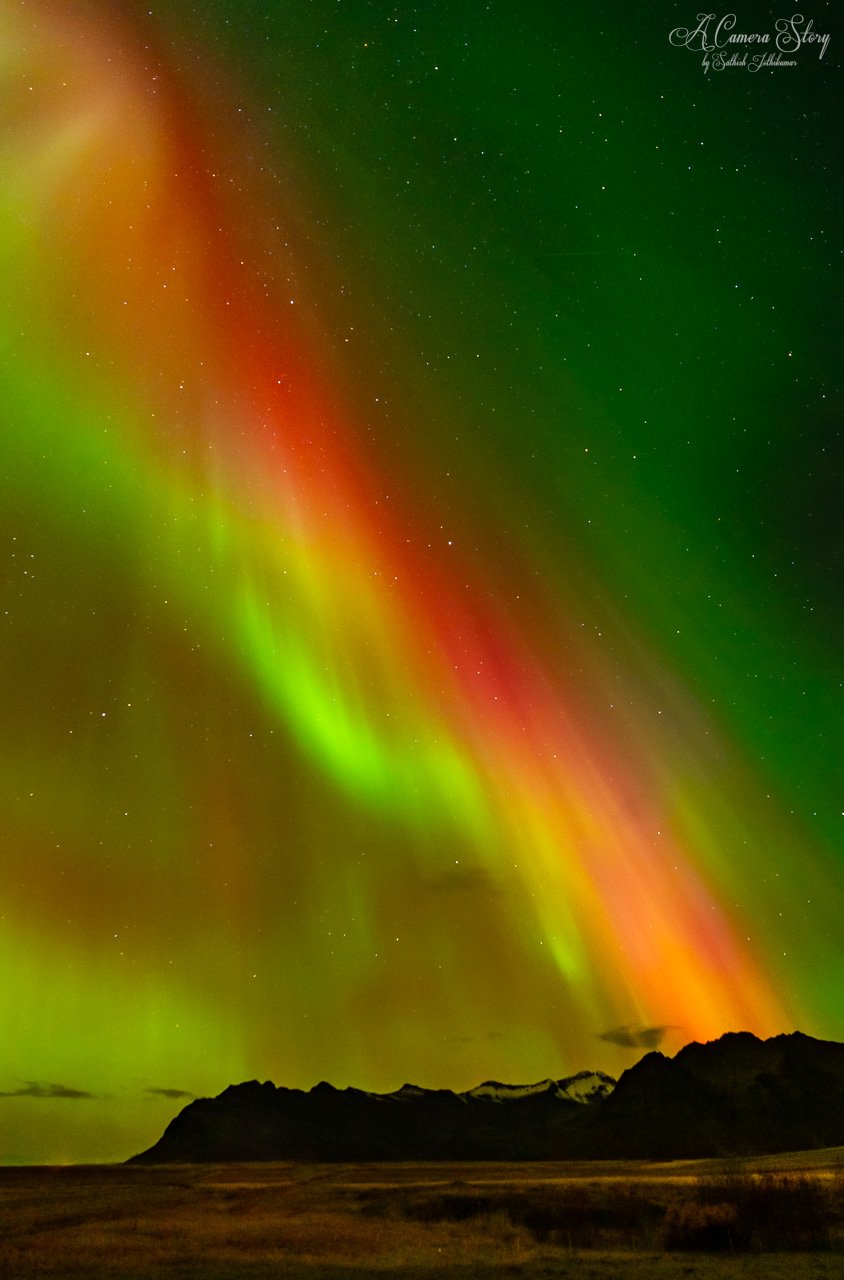Have you looked up at the night sky recently on a clear night? It is mostly a few pinpoints of light often drowned by human-caused light pollution. Look closely up at a really dark night sky at high altitudes, and you'll see the sheer density of stars.
What appears as empty space to the naked eye is teeming with countless points of light. This long exposure reveals the trails of these distant suns as they arc across the night, creating a mesmerizing spectacle. It’s a powerful reminder that we are just a tiny part of something much larger.
This is a 1hr long sequence capturing concentric star trails over the limbs of a dead tree in Bryce Canyon.
Bryce Canyon National Park
UT USA
Diamond in the sky
2024 as a year will be remembered for multiple things. However, one reason for which I will remember this year is witnessing my second totality during the total eclipse in April. After having experienced my first totality back in the 2017 eclipse, I was hooked. This time around, I got to share that experience with both my partner and with a few of my friends.
For the longest period of time, I wasn't even sure if I would be able to travel for the eclipse since my knee wasn't fully healed. Neither was I confident about the weather, which can play spoilsport in April in most of the country. Thankfully, with a few last minute changes, my partner and I were able to catch this years eclipse.
While photography was not as stellar as the one in 2017 due to a thin layer of high altitude clouds, the experience of being in the zone of totality was still unmatched. Here is one of the many photos I took that day, with this one capturing the moment the sun emerged from behind the moon. It features a very bright Baily's beads, with the effect being called a diamond ring of the eclipse. See this large in my 2025 calendar, available for purchase at this link, This is likely the last day to purchase it in order to get it in time for Christmas.
Indianapolis
IN, USA
Trail in the sky
Great Basin National Park had always evaded me so far. Despite having lived in its neighboring state for over 8 years, I never managed to visit this little gem of a park tucked away amidst one of the multitude of mountain ranges marching north to south in Nevada. That is, until now.
My primary goal in the visit to my 59th of the 63 US National Parks was to catch the incredibly dark night skies. After having braved a tiring 5hr drive from Las Vegas, I managed to snag a campsite at the sought after campground near Wheeler Peak. Located at 9900ft (3015m), the high altitude campground features thin air and low air pollution, reducing atmospheric distortion and enables some of the finest astrophotography possible.
Here is one right from the campground I was parked at. See this in large in my 2025 calendar, available for purchase at this link.
Great Basin National Park
NV USA
Icelandic Greenery
From the vast windswept meadows, to the beautiful moss-covered rocks, and the towering mountains, greenery is everywhere in Iceland. But it is only in Iceland that you can see greenery even in the night. When the charged particles from solar wind impacts the earths magnetosphere, the skies above Iceland, being so close to the North pole, lights up in a brilliant display of greens, purples, reds and blues. And during a strong storm, one can even glimpse the rare occurrence of the dance of the aurora, when the bands of the aurora scintillate and change shape by the second.
This was captured during one such brilliant shows above the glacier of Fjallsjokull in Vatnajökull National Park in southern Iceland. See this in large in my 2025 calendar available, for purchase at this link.
Vatnajökull National Park
Iceland
Heart of Flame
Seeing this volcano explode from up close, especially through a telephoto lens at night, really brings the action close to you. First comes the bright showers reaching for the sky before arching down. And just before they hit the ground, the pressure wave from the explosion reaches you. And as it passes by, you also get to watch the burning embers of rock roll down the steep slopes of the volcano.
This was one of the brightest captures from that night of shooting the volcano, and the energy from the explosion is still seared in my mind. See this large in my 2025 calendar available at this link.
Volcan Fuego
Guatemala
A Blast of Red
The geomagnetic storm I witnessed in Iceland on Oct 10 led to perhaps one of the brightest auroral events I had ever witnessed. Even with my eyes blinded by the headlights while driving, I could still see the reds and the pinks in the sky. The splash of color in the sky danced and morphed continuously, highlighting an intensity of storm that was off the charts. A few moments later, when I stopped to take a look, the bulk of the auroral activity was occurring in the southern half of the skies.
I had never seen such bright band of red span across the entire sky from east to west. These colors show up rarely and only during intense storms where the charged solar particles react with Oxygen above 200mi (320km). The typical aurora with green hues occurs from this same reaction occurring at much lower altitudes (60-190mi or 100-300km). This is also why you see the greens band below the reds.
This storm continued for the entire night, though it ebbed and flowed throughout. I was glad I had an opportunity to witness this.
Fjallsárlón
Iceland
And the Curtains part
I distinctly remember where I was when I heard about the May 11 G4 geomagnetic storm that would go on to create auroral displays in nearly all the states in the US. It was a slow-moving storm, and that gave enough time to evaluate locations to catch the aurora. This G4 storm earlier this month came with much less warning and lead-time. This fast moving storm would impact earth in just 24 hrs after it was detected. Were I in the US at that time, I would have struggled to find the right location to shoot it, but I happened to be in Iceland at that time. And while October usually results in changing weather patterns, I happened to be just an hour away from locations with 360 views, fairly calm conditions and very little light pollution.
The intensity of the storm was such that, even with my eyes blinded by headlights, the deep red glow was visible as clear as day as the storm was starting to build up. I pulled over, anticipating a sub-storm that would blow up the sky. And it did. As the intensity of the storm peaked, beams of light stretched from the coronal center all the way to the peaks in the horizon. It was as though the curtains of the sky had parted, and brilliant multi-colored light hiding behind the jeweled night sky filtered from the heavens.
The storm would continue for many more hours of that long night, with periods of quiet interlude between sudden showers of light. Nearly a decade since my first aurora, I couldn't believe that I would get to witness such an incredible spectacle so many more times. It was a night I wouldn't forget for a long time.
Kalfafellsstadur
Iceland
Light of the night
The mother of all solar storms slammed the planet on May 9th. I even briefly observed the Kp scale going down to an unheard level of Kp9. The strength of the storm was 4x of the typical that I had witness in the PNW in the past. And it wasn't just one event, it was a train of half a dozen storms that impinged the planet in that timeframe. And during the height of these impacts, the auroral displays were observed as far south as Mexico, Austria and India, and as far north as Australia.
The internet has been flooded with plenty of images of this event over the past few days. Here is my contribution to this, an example of how the faint glow in the sky was really a dazzling spectrum of colors that arced all over.
North Cascades National Park
WA USA
Rainbow skies
I am still on a high from Friday night.
I had an inkling of how auroras appear out in the PNW: a few pillars of hazy light show up on the northern horizon, lasting a few seconds before disappearing, with the entire show lasting an hour at most.
But last nights G4 storm was something else: a once in 20-year storm that hits intensity levels enough to bring the aurora down to the mid latitudes. And so while we were watching the northern front, the display of lights happened overhead instead. It was strong enough to bring the entire rainbow of colors from exciting Nitrogen (pink), Hydrogen, Helium (blue and violet) and high altitude Oxygen (red).
This Mother's day spectacle is something that I will not forget for a while. It rivaled the display I had seen many years ago in Iceland. Will there be more this year? That is a million dollar question
North Cascades National Park
WA USA
Chasing totality
The chatter on social media over the last few weeks has been the great 2024 eclipse earlier this week.
Tracing a path from south-western Texas all the way across to New England and the north-eastern tip of the US, this eclipse was the last total eclipse in the lower 48 for the next 20 years. While the last eclipse I witnessed was in August of 2017 within driving distance of where I lived, this one required a flight and hop to get to the zone of totality.
While eclipses are easy to predict years in advance, the local weather pattern isn't. It had been a constant
dance of credit cards and booking websites over the last few weeks as I analyzed weather patterns to determine if I was heading to the correct location to catch the eclipse.
While I haven't yet edited the images from this year's eclipse yet, here is totality from the 2017 eclipse in Oregon.
Madras
OR USA







